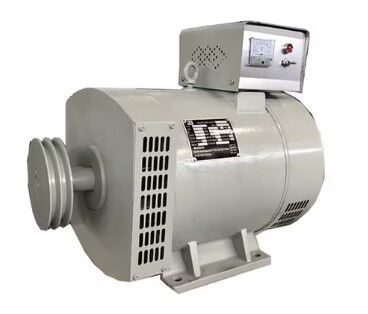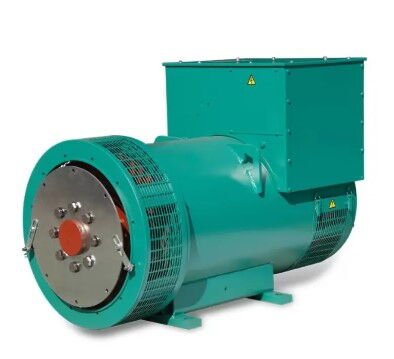When selecting an alternator for a diesel generator set, it is essential to choose the right type based on specific application requirements. Alternators are responsible for converting mechanical energy from the diesel engine into electrical energy, and the type of alternator used can have a significant impact on the performance, efficiency, and maintenance of the entire system. The two main types of alternators used in diesel generators are brushed and brushless alternators. Both types have their distinct features, advantages, and limitations, making them suitable for different applications and operational environments.
In this comparison, we will delve into the working principles, advantages, disadvantages, and practical applications of brushed and brushless alternators in diesel generator sets. By understanding their characteristics, you can make an informed decision based on the specific needs of your generator system.
Brushed alternators are a traditional design that relies on mechanical contact between brushes and a commutator to exchange electrical current. This method has been used in many industrial and residential applications for decades. Despite the rise of newer, more advanced technologies, brushed alternators remain popular in certain scenarios, particularly where cost, simplicity, and ease of maintenance are critical factors.

The working principle of a brushed alternator is relatively straightforward. It consists of a rotating armature inside a stator that produces an alternating current (AC). The armature is connected to the rotating shaft of the diesel engine. As the engine operates, it causes the armature to rotate, generating electricity. This electricity is then transferred to an external load (such as a house, factory, or machinery) via the commutator and brushes.
The brushes, which are made of carbon, are in constant contact with the commutator. The commutator, attached to the rotating armature, directs the current from the armature to the external circuit. While this design is relatively simple and robust, it has some inherent challenges. The friction between the brushes and the commutator generates heat and results in wear over time, leading to the need for regular maintenance and part replacements.
Cost-Effective: One of the primary advantages of brushed alternators is their lower initial cost. The design is simpler and less expensive to manufacture compared to brushless alternatives. For smaller generator sets or budget-conscious applications, this makes brushed alternators an attractive choice.
Simplicity and Ease of Maintenance: Brushed alternators have a relatively straightforward design, making them easier to maintain and repair. The components are readily available, and since the brushes and commutator are accessible, maintenance tasks can be performed with minimal downtime.
Good Starting Performance: Brushed alternators tend to provide better starting torque, which can be beneficial for certain types of loads, particularly those that require a quick surge of power at startup, such as motors or compressors.
Well-Suited for Low-Load Applications: Brushed alternators perform well in applications where the generator is expected to run at lower loads or intermittently, such as backup power systems or small residential generators.
Frequent Maintenance Requirements: One of the most significant drawbacks of brushed alternators is the wear and tear on the brushes and commutator. Over time, the friction between the brushes and the commutator causes both components to degrade, requiring regular maintenance and replacement. This can lead to higher long-term operational costs.
Lower Efficiency: The frictional losses that occur due to the brushes and commutator result in lower overall efficiency compared to brushless alternators. This can be particularly problematic in applications where the generator is required to run for extended periods or under heavy loads.
Shorter Service Life: Because of the wear on the brushes and commutator, brushed alternators generally have a shorter service life than their brushless counterparts. This makes them less suitable for long-term, high-demand operations.
Noise and Heat Generation: The friction between brushes and commutators can generate noise and heat, which may not be ideal for sensitive environments or applications where noise reduction is a priority.
Brushed alternators are ideal for smaller, low-load applications or short-term use where cost-effectiveness, simplicity, and ease of maintenance are paramount. Common applications include:
Small Diesel Generators: Brushed alternators are often found in small diesel generator sets, such as those used for backup power in homes, farms, and small businesses.
Emergency or Temporary Power: Brushed alternators are suitable for situations where temporary or emergency power is needed, such as at construction sites, outdoor events, or as portable power sources.
Low Load Applications: Brushed alternators perform well in applications where the generator does not need to run for long periods under heavy loads, such as in rural areas or remote sites where electricity demands are lower.
Portable or Backup Power Systems: For portable generators used in camping, outdoor activities, or backup power applications, brushed alternators offer a low-cost and easy-to-maintain solution.
Brushless alternators are a more modern design that eliminates the need for brushes and commutators by using electronic components to regulate and control the flow of electricity. These alternators are more efficient, require less maintenance, and tend to have a longer service life compared to brushed alternators. Brushless alternators are widely used in commercial, industrial, and critical applications where reliability and long-term performance are essential.

In a brushless alternator, the rotor is powered by a small exciter generator. The exciter is a small, independent alternator that provides the initial excitation current to the rotor. This current generates a magnetic field that induces electrical current in the stator windings. The process eliminates the need for brushes and commutators by using an electronic system to regulate the flow of electricity.
Brushless alternators typically use a combination of semiconductor components, such as rectifiers and voltage regulators, to manage the flow of electrical energy. This design not only improves efficiency but also reduces the wear and tear that is associated with mechanical components like brushes and commutators. The absence of frictional components means that brushless alternators can operate for much longer periods without the need for regular maintenance.
Low Maintenance: One of the most significant benefits of brushless alternators is that they require very little maintenance. Since there are no brushes or commutators, the need for regular maintenance, such as brush replacements, is eliminated. This results in lower operating costs over the long term and reduces downtime for repairs.
Higher Efficiency: Brushless alternators are typically more efficient than their brushed counterparts because there are no frictional losses from brushes and commutators. This increased efficiency is especially beneficial in high-demand or continuous-use applications where energy conservation and operational costs are key concerns.
Longer Service Life: The lack of wear-prone components gives brushless alternators a significantly longer service life compared to brushed alternators. This makes them ideal for continuous operation or applications where the generator is expected to run for extended periods.
Better Performance Under Load: Brushless alternators can maintain stable voltage and current under varying loads, providing better performance in applications with fluctuating energy demands.
Quieter Operation: Without the friction between brushes and commutators, brushless alternators are generally quieter in operation, making them suitable for noise-sensitive environments such as hospitals, data centers, or urban settings.
Higher Initial Cost: Brushless alternators are typically more expensive than brushed alternators due to the advanced technology and electronic components involved. This initial cost can be a significant consideration for smaller or budget-conscious projects.
Complex Design: Brushless alternators are more complex than their brushed counterparts, requiring specialized knowledge and skills to design, maintain, and troubleshoot. This complexity may not be ideal for applications that require simple solutions or have limited technical expertise available.
Lower Starting Torque: While brushless alternators excel in continuous operation, they may have a lower starting torque compared to brushed alternators. This can be a drawback for applications requiring high startup currents, such as large motors or equipment with heavy initial loads.
Brushless alternators are ideal for applications where reliability, efficiency, and long-term performance are crucial. They are used in larger, high-demand generator sets and critical infrastructure applications, including:
Large Diesel Generator Sets: Brushless alternators are commonly found in large diesel generator sets used for industrial, commercial, and institutional applications.
Continuous Power Generation: In facilities that require constant, uninterrupted power, such as hospitals, data centers, and large commercial buildings, brushless alternators provide a reliable solution.
Industrial and High-Load Applications: Brushless alternators are suitable for industries with high energy demands, such as mining, manufacturing, and oil extraction, where continuous operation under varying loads is essential.
Critical Infrastructure: For backup power in critical infrastructure, such as airports, communication networks, and emergency response facilities, brushless alternators provide stable, high-quality power.
When deciding between brushed and brushless alternators for a diesel generator set, several factors need to be considered, including application type, maintenance requirements, operational costs, and efficiency needs. Here are some key comparisons to help guide the decision-making process.
Brushed Alternators: Brushed alternators are less expensive upfront, making them suitable for smaller projects or temporary applications where budget constraints are a concern.
Brushless Alternators: While more expensive initially, brushless alternators offer lower maintenance and operating costs over the long term, making them a better investment for continuous-use applications.
Brushed Alternators: Require regular maintenance, including brush replacements and commutator inspections. Their reliability decreases over time due to the wear of mechanical components.
Brushless Alternators: Require minimal maintenance, making them more reliable and suitable for long-term, high-demand applications.
Brushed Alternators: Have lower efficiency due to frictional losses. Their performance may degrade over time as the brushes wear out.
Brushless Alternators: Offer higher efficiency and stable performance, especially under fluctuating loads, making them ideal for industrial and critical applications.
Brushed Alternators: Best suited for small, low-load, or short-term applications such as portable generators, residential backup power, and construction sites.
Brushless Alternators: Ideal for larger, high-demand applications such as commercial buildings, industrial operations, and critical infrastructure that require continuous, stable power.
Both brushed and brushless alternators have unique benefits that make them suitable for different types of diesel generator sets. Brushed alternators are cost-effective and well-suited for smaller, low-load applications where maintenance and operational simplicity are more important than long-term efficiency. On the other hand, brushless alternators are more efficient, reliable, and require less maintenance, making them ideal for larger, high-demand, and continuous-use applications. The choice between brushed and brushless alternators depends on the specific requirements of your diesel generator system, including budget, load demands, and desired operational life. By understanding the strengths and limitations of each type, you can select the most appropriate alternator to meet your needs and ensure optimal performance of your generator set.
